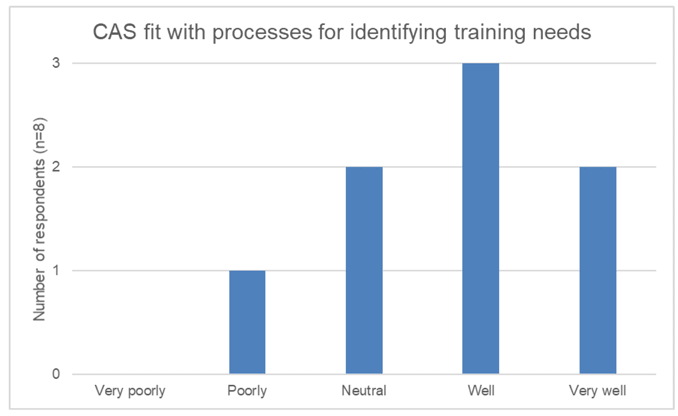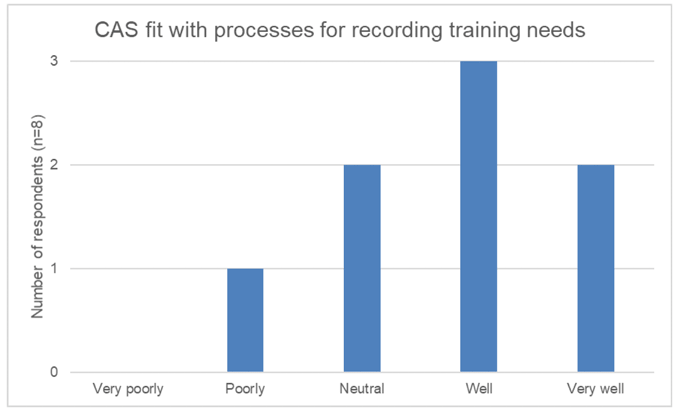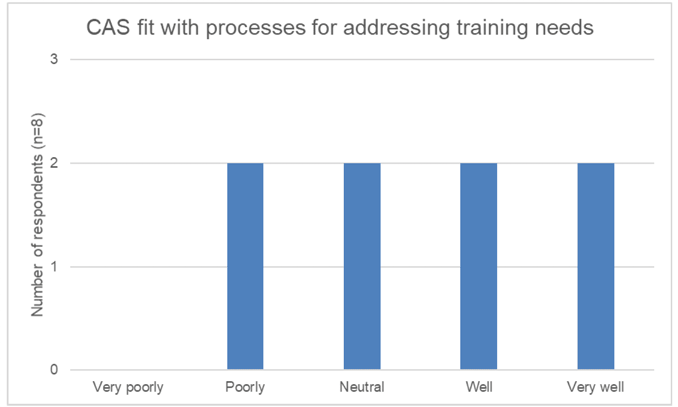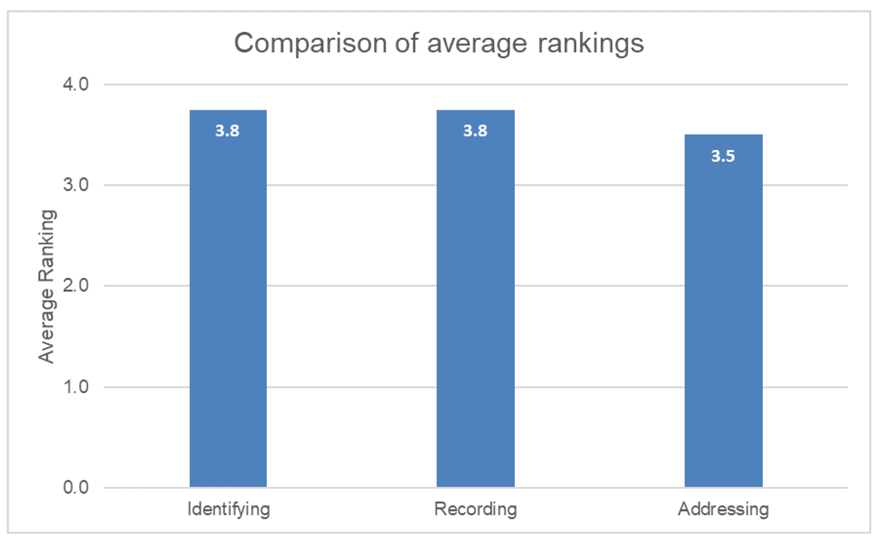Building standards - verifiers management and training and development recording: review
A study to investigate how the recording of training needs identified through the Competency Assessment System (CAS) is managed. Also how the current systems and processes can inform the development of a learning and development hub for the building standards profession.
This document is part of 2 collections
3. CAS Process
3.1 Introduction
3.1.1 This section sets out the experience of respondents who have undertaken some assessments using the new CAS and toolkit.
3.2 Strengths of New CAS Process
3.2.1 Just under half of the respondents (46%) reported that they had undertaken assessments using the new CAS. These six respondents were then asked to identify what aspects of the process worked well in relation to the five steps of the CAS process. The responses provided at each stage are summarised below, but it should be noted that not all respondents provided an answer relating to each step:
3.2.2 Assessment planning and agreement: feedback suggested that respondents had generally found this step to be fairly straightforward. However, some respondents felt it was very time-consuming. It was helpful to have a generic template for all levels of staff, but one respondent felt that "Each LA requires to carefully consider the Competency Framework and develop their own approach. Critical to do this and to engage with all employees in the process."
3.2.3 Evidence gathering by candidate: a couple of respondents thought this step was straightforward. However, there was some concern over this step of the process which is explored below in paragraph 3.3.3.
3.2.4 Assessment: the responses indicated that this step is regarded as working well with one respondent stating that "[The] Template is beneficial especially for members of staff starting in [their] career and working through grades."
3.2.5 Assessment and decision making: a couple of respondents reported that this step offered a structured approach. One LA stated that this step was "In progress but intended outcome is a BS Training Plan. As a result, there may be representations to BSD/LABSS for support in developing 'national training and development issues."
3.2.6 Recording outcomes: again, a couple of respondents reported that this step offered a structured approach. One respondent made the point that they had "Recorded the outcome but it is monitoring this that is important and how we do that which will make the difference."
3.3 Weaknesses of New CAS Process
3.3.1 The survey asked what aspects of the process did not work as well as expected in relation to the five steps of the CAS process. The responses provided at each stage are summarised below, but not all respondents provided an answer relating to each step and one respondent noted that each step would be evaluated in due course with the team and through LABSS.
3.3.2 Assessment planning and agreement: a few respondents felt that this step was time and labour-intensive, with one respondent concerned that there are too many boxes to populate making the process too screen intensive. The process is challenging for people who are colour blind/suffer from migraines.
3.3.3 Evidence gathering by candidate: a couple of respondents felt that this step of the CAS resulted in little specific evidence being provided by candidates, but rather an 'agreement in principle' is made. One respondent felt this step to be "Time consuming and cumbersome. Level of information required and document is extensive and we have had time issues trying to do this. Will be easier for new recruits working way up as can gather as they go rather than do it retrospectively."
3.3.4 Assessment: again, a couple of respondents felt this step was time-consuming and noted that there was some duplication of information between the CAS assessment and the staff appraisal process.
3.3.5 Assessment and decision making: respondents did not make comments specific to this step.
3.3.6 Recording outcomes: a couple of respondents repeated concerns that the process is time-consuming. One respondent felt that while the spreadsheet was useful at present, they would like to see it integrated into a software package for ease of use and reporting.
3.4 Overall Assessment of New CAS Process
3.4.1 Respondents were asked to rate how well they think the new CAS and toolkit fit into their existing processes for identifying, recording and addressing training and development needs on a scale of 1 to 5 where 1 is very poorly and 5 is very well. Figure 3.1 provides a summary of responses for each part of the process – identifying, recording and addressing training needs[4].
3.4.2 The Figure shows that respondents rated the CAS and toolkit fairly positively in terms of the fit with existing processes for identifying and recording training needs with over half stating they fit well or very well. The Figure also shows the fit into existing processes for addressing training and development needs is rated slightly lower with over half of respondents in this case having selected poor or a neutral response.
Figure 3.1: Summary of How Well New CAS Fits within Existing Processes



3.4.3 Figure 3.2 compares the average rating across each of the three stages of the current system. The results confirm that with an average value of 3.8, the new CAS process is a better "fit" with current systems when it comes to identifying and recording training needs. In terms of addressing training needs, the CAS had an average rating of 3.5.
Figure 3.2: Comparison of Average Ranking for Fit of CAS with Current System

3.4.4 The survey sought to explore the reasons for the selected rankings above. The analysis is presented across all three stages of identifying, recording and addressing training and development needs as there were several duplicate answers across the three stages.
3.4.5 Respondents rating the fit of the CAS and toolkit positively offered reasons relating to the clarity and usefulness of the template:
"It takes what we do presently and extends to give a standard template for us to follow."
"Job specific roles are clearly defined with all elements of relevant technical standards taken into consideration."
"The template provides a user-friendly key to identify training needs, the type of training required, and when that training has been completed."
"The CAS is broken down in a way that leaves nothing out in terms of our role and therefore it is very straightforward to follow in this regard - if a colleague has noted fully achieved then they can demonstrate how they have achieved that aspect, however if they haven't, following discussions with that colleague training can be easily identified on what is needed to fully achieve that aspect."
"The CAS system is good, it just needs to be applied flexibly."
3.4.6 Respondents rating the fit of the CAS and toolkit less positively offered the following reasons:
"Duplicates existing processes[5], overly time-consuming and removes some of the Line Managers' autonomy."
"Difficult to fully assess at this time. The process is too protracted and our Service has as yet not completed the assessment for the full establishment."
"Lack of specific training available [to address training needs]."
3.4.7 The survey concluded by asking the respondents if they would like to make any further comments on the CAS and its toolkit. The responses are summarised below by theme:
General support for CAS
- "A very well-developed plan to ensure staff have the relevant competencies to undertake their respective duties, identify and record training needs."
- "CAS is a significant step forward in terms of identifying training needs that are specific to building standards."
- "The CAS is an excellent development tool and puts building standards competency requirements at the core of the development process. It does require each LA to carefully consider how they implement the framework and engagement across the whole team is critical. To be successful, it is important that LAs,' BSD and LABSS support the delivery of training needs in terms of events/opportunities and also funding, although it should be recognised that development takes many forms, including support, mentoring rather than being solely training."
- "The CAS although a considerable piece of work to complete is a very useful tool that helps verifiers set out training required - if this training can be identified nationally it could be more easily addressed instead of each verifier arranging their own training."
Complexity of CAS process
- "The concept is sound; however, the process should be greatly simplified. I suspect, any process that relies on such a complex toolkit is not going to achieve any degree of National consistency. It has been stated several times that it can be adapted to suit local circumstances/structures/service priorities, I would suggest such a statement backs up my view. Building Standards teams across the Country are asked to engage in an ever-increasing range of tasks and duties - this process focuses only on competency re Building Standards."
- "On first inspection of the CAS document and supportive guidance documents it appears way too complicated, lengthy and dare I say; not fit for purpose. The building standards management team have spent almost 2 days (x 2 TLs and 1 BS manager) trying to understand this new process. Assessing the professional competency of an individual within my team shouldn't take the 4hrs that LABSS say will be required per person to initially set the process running. In a team of 28 surveyors the new CAS process will take 14 days to complete."
Duplication of existing systems
- "In principle this is supported in its very clear intent, however, each LA has its own processes and if carried out fully, the CAS has not yet offered us real benefits for the time it takes all involved to complete. It would be ideal if it was the only competence system in place in an authority but we as an example now have a requirement which duplicates assessment, recording and monitoring which puts further strain on the other processes required of the Verifier."
Contact
Email: buildingstandards@gov.scot
There is a problem
Thanks for your feedback